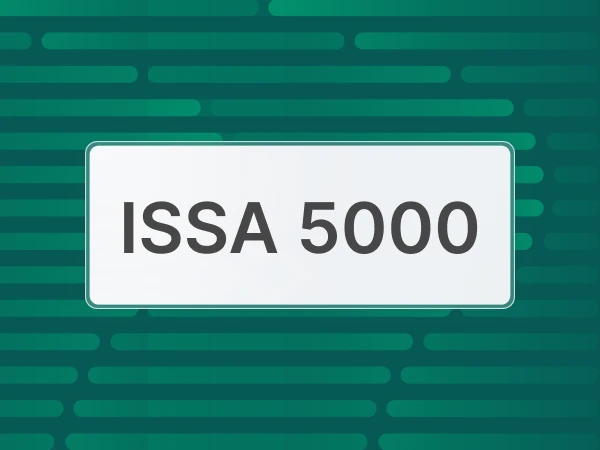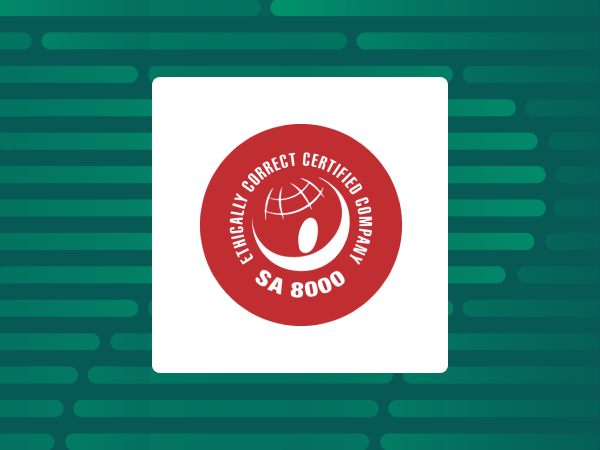{summary#bullet-1}
What is SA8000 certification
The voluntary international standard SA8000 (Social Accountability 8000) It's one sustainability certification designed to improve working conditions within organizations and along the entire supply chain.
First published in 1997 by Social Accountability International (SAI), the standard was subject to revisions in the following years, and is now recognized globally as one of the most credible tools for demonstrating the ethical commitment From a company to a larger one social sustainability.
This certification is based on the principles of the most relevant international conventions in the field of human and labor rights, such as those of the International Labour Organization (ILO), the Universal Declaration of Human Rights and the UN Convention on the Rights of the Child.
The SA8000 establishes strict requirements for the protection of workers' rights, the promotion of safe and decent work environments, the prevention of all forms of discrimination and exploitation, the prohibition of child labor and forced labor, the enhancement of people through training and professional development, up to the extension of these criteria also to suppliers and subcontractors.
Although it does not cover all aspects of Corporate Social Responsibility, the SA8000 represents one of the fundamental pillars for organizations that want to stand out for their social commitment, improving its internal governance and contributing concretely to the well-being of workers.
The involvement of independent third parties for the issuance of the certification reinforces the credibility of the path undertaken and allows companies to reduce reputational risk, demonstrating with transparency the consistency between declared values and practices adopted.
{summary#bullet-2}
Who does the SA8000 certification apply to
The SA8000 certification is designed to be adopted by any type of organization, regardless of the sector to which they belong, the size or the legal nature, public or private. His flexible structure allows a transverse application, making it a tool accessible to both small and medium-sized enterprises and large multinational groups, operating in very different productive environments.
The SA8000 is particularly strategic for companies active in high-risk sectors of human rights violations or with complex global supply chains, especially in countries where the protection of workers may be lacking. At the same time, however, it also represents a concrete opportunity for all those organizations that want to stand out for their commitment to social responsibility, work ethic and human sustainability.
{summary#bullet-3}
What are the requirements to obtain SA8000 certification
To obtain SA8000 certification, an organization must demonstrate compliance with a series of ethical and social requirements that involve every area of its activity, from internal working conditions to the responsible management of the production chain.
The standard is configured not only as a technical standard, but as a real one Declaration of Commitment towards the protection of human rights and the promotion of the dignity of work in all its forms.
The standard, inspired by the main international references in the field of human and labor rights, is divided into nine macro-principles that must be integrated into company policies, operational processes and organizational culture. These requirements are not mere documentary requirements, but require a structural change and an active and continuous commitment on the part of management and all the people involved.
In addition to complying with these requirements, organizations must ensure that suppliers, subcontractors and strategic partners are aligned with the same standards, contributing to the construction of a socially responsible value chain.

{summary#bullet-4}
The 9 steps to obtain SA8000 certification
The SA8000 certification is issued by Social Accountability International (SAI) who, in addition to being responsible for the issuance of certifications, is also responsible for upgrade And of the developmental of the standard itself at a global level.
To obtain the SA8000, the path that an organization must take is a lot stringent. The certification process consists of 9 phases fundamental, which guarantee transparency, traceability and continuous improvement.
Let's see what they are
- Self-assessment: test available directly from SAI website which helps interested organizations understand the requirements of the SA8000 management system and determine if they are ready to apply for certification.
- Preparing for the audit: the organization collects the necessary documentation and analyzes its internal practices in relation to the issues of social responsibility, health and safety, human resource management and workers' rights.
- Initial Audit: the certifying body carries out an inspection visit to assess the current situation. In this phase, documents are analyzed, interviews are conducted with workers and managers, operational processes are observed and objective compliance elements are collected.
- Conformity Assessment: auditors verify timely compliance with SA8000 requirements, such as the prohibition of child and forced labor, the absence of discrimination, safety at work and freedom of association.
- Collection of evidence: documentary evidence and direct testimonies are acquired to support the evaluations carried out during the inspection phase.
- Preparation of the audit report: the certification body draws up a detailed document that reports the results that emerged and indicates any non-compliance.
- Planning corrective actions: if critical issues are detected, the organization is required to draw up an improvement plan to realign itself with the criteria of the standard.
- Follow-up audits: once the corrective actions have been implemented, a subsequent check is carried out to verify if the measures taken have actually remedied the non-compliances.
- Issuance of certification: if the organization is fully compliant, it receives the official SA8000 certification.
Once the certificate has been obtained, there is a system of periodic surveillance, with biannual inspections, and a re-certification every three years, which allows the organization's social performance to be monitored and consolidated over time.
{summary#bullet-5}
How to verify the implementation of the provisions of the SA 8000 standard
To ensure the effective implementation of the provisions of the SA8000 standard, organizations must adopt a systematic and participatory approach, based on risk assessment and shared accountability between management and workers.
A key element of this process is the establishment of a Health and Safety Committee, a body provided for by the SA8000 standard, composed in a balanced way of representatives of management and workers. This committee is responsible for conducting regular formal risk assessments, both real and potential, for health and safety, and to define appropriate corrective and preventive actions.
The activities of the committee must be Documented in a timely manner and the decisions taken must be Communicate clearly to all staff, promoting a corporate culture based on transparency and continuous improvement. These decisions must also be disclosed to the outside world, in particular to their vendors, to promote greater awareness.
Finally, the Committee must receive a training specific and constant, to guarantee the necessary competence in dealing with problems related to health and safety.
In addition to the internal context, the verification of the implementation of the SA8000 standard also extends to the entire supply chain, through a risk assessment that considers all potential threats to human rights and working conditions throughout the production cycle. This assessment makes it possible to identify any violations, to implement corrective measures and to strengthen company policies, staff training, auditing activities and dialogue with stakeholders.
{summary#bullet-6}
The 7 advantages for companies of joining the SA8000 certification
The adoption of the SA8000 standard is not only a declaration of ethical commitment, but also a Strategic lever concrete for the growth, reputation and competitiveness of companies, constituting a competitive advantage compared to the competition.
Organizations that decide to certify themselves according to this management model obtain a series of tangible advantages, both internally and externally, with positive effects on stakeholders, employees, customers and institutions.
Let's see what are the main benefits that make the SA8000 a valuable investment for businesses.
- Increased credibility and reputation
The SA8000 certification clearly communicates the company's commitment to human rights and social responsibility. This translates into a better position on the market, greater transparency and recognition by customers, partners and investors, significantly reducing reputational risk. - Increased trust from customers, consumers and stakeholders
Certified organizations enjoy a higher level of trust, as they are perceived as responsible and trustworthy. This strengthens relationships with institutions, social organizations and communities, improving dialogue and cooperation with stakeholders. - Access to new markets and business opportunities
In a global context where compliance with ESG objectives is increasingly in demand, SA8000 can represent a competitive advantage in public tenders, in calls for funding and in collaborations with companies that place ethical criteria in the selection of suppliers. - Improving the business climate and internal cohesion
Attention to people's well-being and dignity is reflected in a healthier, more collaborative and motivating work environment. Employees feel listened to, protected and an active part in achieving business objectives, increasing their sense of belonging and productivity. - Greater involvement of employees and suppliers
The SA8000 promotes a participatory approach that stimulates the direct involvement of workers and stakeholders in the definition of company policies. The supply chain is also empowered, creating a stronger network consistent with the organization's values. - Strengthening internal management and improving processes
The implementation of the SA8000 system pushes the organization to structure effective procedures, forms and monitoring tools. This leads to greater operational efficiency, better risk management and continuous improvement in business performance. - Award scores and incentives in public tenders
Being certified according to the SA8000 standard can represent a rewarding criterion for participation in calls for tenders, funded projects and public incentives, especially in sectors where social and ethical commitment is valued in technical evaluations.






























